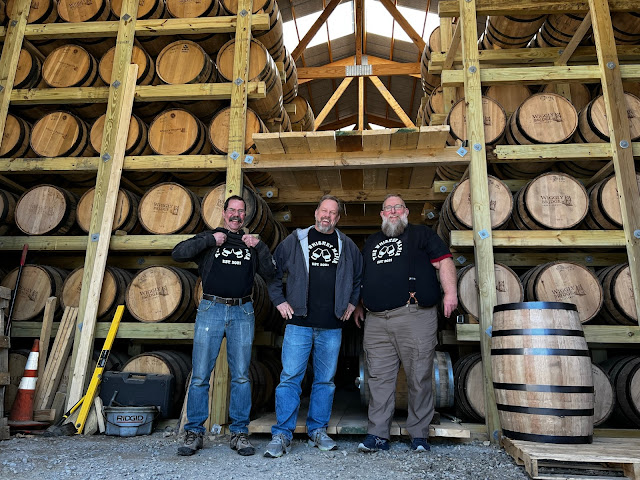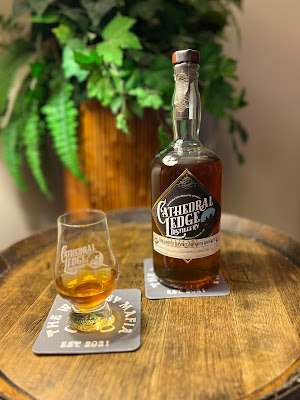Maybe not everyone who enjoys something wants to try making it themselves, but Dan, Mitch and I (and possibly you, dear reader) have an interest in whiskey that goes beyond drinking the spirit. We've experimented with aging white whiskey, corn whiskey and even re-barreling a bourbon in our nano-barrel. We've studied the distilling and aging process, and even attended barrel tastings at a local craft distillery. We've always wanted to have a hands-on experience making whiskey, but unlike home brewing, it isn't legal to do it at home without a license.
So back in February, 2020 (yeah, that's right) when our friend David at Wiggly Bridge Distilling in York Beach, Maine told us about the distillery's Distiller for a Day program, Dan and I jumped at the chance to sign up for the experience. The program was very hands-on. The master distillers literally put you to work in the cooking, fermenting, distillation and barreling process, at least to the extent that you can do it in a day.
As you might expect, we didn't get to "make the hooch" in 2020, and we didn't get to go in 2021 either, but at last in April of 2022 we got the call from David that he and David Jr. would host a Saturday class for us, including Mitch, who joined the group after our original visit to the distillery.
Distilling Bourbon as Distiller for a Day at Wiggly Bridge
When our long awaited date came around, the three of us arrived at the distillery a little before 9:00 AM. After a warm welcome and a quick orientation, the Woods men put us right to work unloading a pallet of grain and leaning them up against the cooker as it filled with water.
Once the water had heated up a bit, it was time to start adding the grain to the cooker. Wiggly Bridge's bourbon uses an ultra-high rye mash bill made up of 58% corn, 37% rye and 5% malted barley. That meant that we had to add 15 bags of corn, 9 bags of rye, and one bag of barley malt to the cooker. The cooker is steam heated and has a large agitator in the middle to keep everything well stirred.
Corn goes in first and cooks for 40 minutes after the water reaches 140 degrees before the rye is added. During this time the mash continues to heat up to 188 degrees, but it has to be cooled back down to 145 degrees before barley is added to the mash in order to avoid damaging the enzymes that are needed from the malt.
While the corn was still cooking, we started a spirit run in the smaller of Wiggly Bridge's two copper pot stills. Sprits are double distilled. The first distillation, called the stripping run, removes the solids from the fermented mash, or "beer" and extracts a lower proof alcohol, called "low wines." The spirit run extracts the "high wines, which can be divided into heads, hearts and tails.
As David likes to say, when you look at the actual physical work that they do, distillers are really in the "fluid transportation business." Starting the sprit run required that we connect a commercial food-grade pump to the storage tank holding the low wines, and to the spirit still and then pumping the appropriate volume into the still.
The Waiting and The Grains
As it turns out, the other thing distillers do a lot of is waiting. Waiting for the corn to heat up to 140, waiting the 40 minutes for it to cook before adding the rye, and waiting for the distillation process to run its course.
While we waited, we learned about the Woods' corn, which is a locally grown hybrid of Bloody Butcher, Ohio Blue Clarage, and #2 Yellow Dent. The tale of how this blend came about is an interesting anecdote of David's about a several conversations with a patron of the distillery who happened to be a local farmer with a farm in Ohio who wanted his business. I really couldn't do justice to the story here even if I had the space, so you'll have to hear that one when you visit Wiggly Bridge. The malt is also local, having been grown and malted in Maine by Lewiston-based
Blue Ox Malthouse.
Heads, Hearts and Tails
After a few minutes learning about the grains Wiggly Bridge uses, we headed back down into the still room to taste the distillate to see where we were in the process. David Sr. measured the spirit with a digital hydrometer, but we also tasted the distillate to see if we were out of the heads (most of which are set aside for the next run) and into the hearts.
As most people know, the goal of beverage alcohol production is Ethanol, but the process also produces a number of other compounds including acetaldehyde (which gives some bourbons their green apple aroma), acetone (nail polish remover), methanol, and ethyl acetate. These compounds have a lower boiling point than ethanol and come off the still first. They are referred to as the "heads." Too much of these compounds in your whiskey and you could get pretty sick, but small amounts are an important part of what gives bourbon its flavor.
You also get compounds other than ethanol at the end of the spirit run, including propyl alcohol (rubbing alcohol), acetic acid (vinegar), and amyl alcohol (which has a fruity aroma often compared to bananas or pears). These compounds known as "tails" are harmless, but too much of them will produce a sprit that you probably won't want to drink. As with the heads, part of the art of making bourbon is knowing when to cut off the tails so you get some of the flavors but not too much.
The bulk of the distillation run is in the hearts, so most of the rest of the day's activities actually took place between the heads and the tails of our spirit run.
Filling the Bourbon Barrel
After lunch, one of our first tasks was to fill our barrel, which due to the timing of things was neither from our cook nor from our spirit run, but instead from white dog distilled earlier. The first step was to sign the head of the barrel, so we can come back and taste it as it progresses through the aging process and eventually buy bottles of the finished bourbon.
The distillery keeps its finished white dog in a plastic storage tank, where it is rough proofed below the 125 maximum barrel entry proof using carbon filtered local water and mixed by pumping the white dog from the bottom of the tank to the top of the tank.
Once the distillate is proofed to the right level, we used the same pump as was used in the mixing process to pump the white dog into a new charred oak barrel. At this point the distillate is officially both whiskey (because its been put into an oak container) and bourbon (because that container was new charred white oak). We each then got a chance to pound the bung into the barrel with a rubber mallet.
Once the barrel was filled and sealed we carefully rolled it onto a forklift and placed it to rest temporarily in a storage container, because the distillery's rickhouse is near capacity and the new rickhouse is yet to be completed. We also got to go "tour" the rickhouse and take some pictures with six million dollars worth of aging bourbon, which made for a great photo (at the top of this post.)
We also checked out the basement under the distillery where several experimental products are aging including the distillery's first single malt whiskey.
Blending Barrels to Make the Finished Bourbon Flavor Profile
 |
| Eight single barrel samples represent a batch. |
Once our barrel had been laid down to age, we moved upstairs over the distillery to learn about how barrels are selected and blended together to form a batch of the finished product. The word "blend" is often used to describe mixing different types of whiskey, or perhaps clear spirits into a finished product, but that's not what we're talking about here. Instead, we worked with eight samples from eight different barrels that make up the current Wiggly Bridge Small Batch.
David Sr. first poured us a small sample from each and asked us to taste and rank them on a three point scale: the single barrels we thought were good, the ones that were OK, and the one we really didn't care for.
Next, David mixed and rough proofed three different blends: Fist, he made a blend of just the bottles we liked. Then, he made a blend of the bottles we liked and the so-so bottles. Finally he made a blend that included the bottle we didn't like, and we tasted all three. Ultimately, each iteration tasted a little better and a little more complex than the one before it, which goes to show that even a barrel you may not like alone can contribute something positive to the flavor profile of the finished batch.
Even though we weren't necessarily surprised by the result, it was very interesting to participate in the process personally and actually experience the process of mingling barrels to form a batch.
The Final "Fluid Transportations"
 |
Mash being pumped into the fermenter.
|
Before we could call it a day, we had just two more tasks to complete. We had to pump the finished white dog from our spirit run into the plastic storage tank for the next barrel fill. Then, we had to pump our finished cook into one of the distillery's three wooden fermenters. Once the completed mash was in the tank, David, Jr "tossed" the distillery's signature Scottish yeasts into the mash to start the fermenting process. The completed beer would ferment for a few days and ultimately be distilled about 5 days later.
At the end of the day there was an "I made the hooch" t-shirt and of course we visited the distillery shop to "transport" some sprits home with us! Overall, it was a fantastic day of learning about the distillation process first-hand by working on all of the major steps of the process. Many thanks to David Woods, Sr and David Woods, Jr for offering this experience. If you're in the area and would like to give it a try, we'd definitely recommend the
Distiller for a Day experience!













Comments
Post a Comment